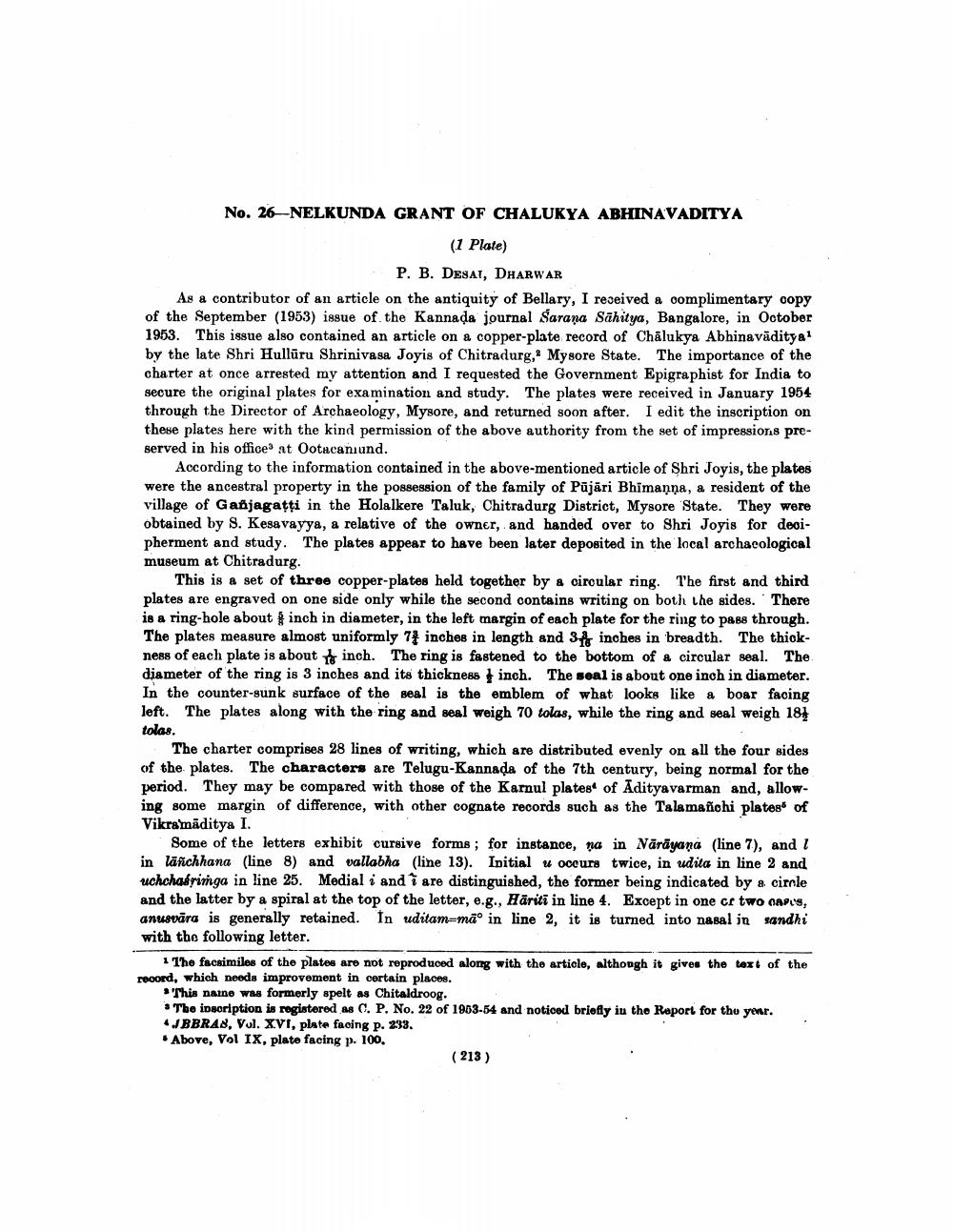________________
No. 26-NELKUNDA GRANT OF CHALUKYA ABHINAVADITYA
(1 Plate)
P. B. DESAI, DHARWAR
As a contributor of an article on the antiquity of Bellary, I received a complimentary copy of the September (1953) issue of the Kannada journal Sarana Sahitya, Bangalore, in October 1953. This issue also contained an article on a copper-plate record of Chalukya Abhinavāditya1 by the late Shri Hulluru Shrinivasa Joyis of Chitradurg, Mysore State. The importance of the charter at once arrested my attention and I requested the Government Epigraphist for India to secure the original plates for examination and study. The plates were received in January 1954 through the Director of Archaeology, Mysore, and returned soon after. I edit the inscription on these plates here with the kind permission of the above authority from the set of impressions preserved in his office at Ootacaniund.
According to the information contained in the above-mentioned article of Shri Joyis, the plates were the ancestral property in the possession of the family of Pūjāri Bhimanna, a resident of the village of Gañjagatți in the Holalkere Taluk, Chitradurg District, Mysore State. They were obtained by S. Kesavayya, a relative of the owner, and handed over to Shri Joyis for deoipherment and study. The plates appear to have been later deposited in the local archaeological museum at Chitradurg.
This is a set of three copper-plates held together by a circular ring. The first and third plates are engraved on one side only while the second contains writing on both the sides. There is a ring-hole about inch in diameter, in the left margin of each plate for the ring to pass through. The plates measure almost uniformly 7 inches in length and 3 inches in breadth. The thickness of each plate is about inch. The ring is fastened to the bottom of a circular seal. The diameter of the ring is 3 inches and its thickness inch. The seal is about one inch in diameter. In the counter-sunk surface of the seal is the emblem of what looks like a boar facing left. The plates along with the ring and seal weigh 70 tolas, while the ring and seal weigh 18 tolas.
The charter comprises 28 lines of writing, which are distributed evenly on all the four sides of the plates. The characters are Telugu-Kannada of the 7th century, being normal for the period. They may be compared with those of the Karnul plates of Adityavarman and, allowing some margin of difference, with other cognate records such as the Talamanchi plates of Vikramaditya I.
Some of the letters exhibit cursive forms; for instance, na in Narayana (line 7), and l in lañchhana (line 8) and vallabha (line 13). Initial u occurs twice, in udita in line 2 and uchchasrimga in line 25. Medial i andì are distinguished, the former being indicated by a circle and the latter by a spiral at the top of the letter, e.g., Häriti in line 4. Except in one or two CAPES, anusvāra is generally retained. In uditam-ma° in line 2, it is turned into nasal in sandhi with the following letter.
1 The facsimiles of the plates are not reproduced along with the article, although it gives the text of the record, which needs improvement in certain places.
This name was formerly spelt as Chitaldroog.
The inscription is registered as C. P. No. 22 of 1953-54 and noticed briefly in the Report for the year. JBBRAS, Vol. XVI, plate facing p. 233. Above, Vol IX, plate facing p. 100.
(213)




